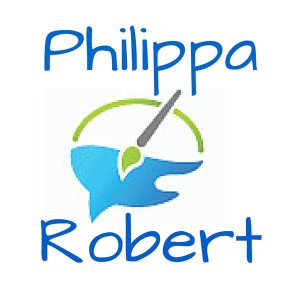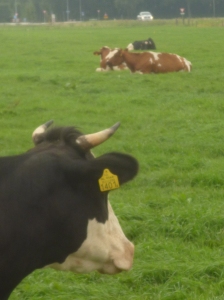After our morning at the Cranium, my fellow artist and I set off in search of cows-at-close-range. This is more difficult than you might think in Holland. Cows are plentiful but they graze in neat rectangular fields edged by ditches and often flanked by main roads or roads with cycling tracks, even out in the ‘wilds’. If you have visited the Netherlands, you will know how perilous it would be to set up on cyclists’ territory.
Our eventual vantage point was a dead end road running about 300 metres between the greenest fields in the world.
It is amazing to see the density of the cow population in Europe compared to the paddocks in Australia. There are a few factors involved I imagine. Among these, rainfall, soil and pasture quality and to quote this gal “I mooved here to get away from the heat.” She turned away immediately after her comment – shyness, or embarrassment perhaps about the bad joke.
So, to the output. Unfortunately I didn’t take the initiative to photograph my colleague Herman’s creation which I think was masterful. Perhaps I can persuade him to send an image. Watch for an update!

Hints of an ainimal (acrylic on water colour paper)
Soon I realised that reflexes are everything! Pamplona has never been on my itinerary, but still this was a jolt. Cows are slow moving, aren’t they? Yes, but they change position often. Eating, if not on-the-run, certainly on the move.

A small page of sketches. The cow on the left (the refugee from Australia’s heat) rather spoilt the perspective by wanting to loom large. But that was a personality thing.

Here she is again. She greeted us with something fairly earthy, so perhaps that is why she faced away from us. Not really sure.

Lazing and grazing. Did you know that cows doze off with their nose just dipped into the grass? That’s how it looked. How do they balance the weight of their enormous heads like that? As time passed, they all took a rest. Too bad, as they are much more interesting standing up!
By this time we had been visited by several people: The Farmer in a ute, a worker in a huge ploughing machine with snarly arms which stretched across the narrow road and threatened to knock us and our easels over, a woman with a dog which could run off the leash along this road, and mother and child on a bicycle. They all spoke a sort of guttural, explosive Dutch but is surprising how predictable those conversations are! Hobby or professional? How long has this been a pursuit? We learned that an artist who paints only cows and horses lived “over there.” The Farmer was keen to buy my colleague’s painting if it worked out (which it did) but Herman was reticent to show him the work when he returned as we packed up. The complications outweighed the advantages I think.
No-one was really surprised to see painters out there. The word “landscape” comes from the Dutch language according to my Lonely Planet pocket guide, and there is a strong tradition of painting big skies and low horizons in that flat land.
Working with someone else, I persisted much longer than I would have alone. And tackling two such different subjects. From delicate airy cranes to hefty living creatures….
Phew! It was quite a day.



great cowscapes P:-) x
smiling! thanks V!
Philippa, your tales of summer travels could make for one interesting autobiography (if you ever choose to write one!) To work outside en plein air – so publicly compared to how I work – I would find so challenging; that’s why I love to hear about your interactions w/ passers-by! Your quote, “She greeted us with something fairly earthy, so perhaps that is why she faced away from us” re: your cow subject has me still in stitches laughing!!! Fantastically enjoyable post.
It is good to hear that you enjoyed it Patricia! I let loose a bit.
Thanks for the udder view of your travels – you milked it well. I am cowed by your paintings…
I pay fromage to you John! very clever :>